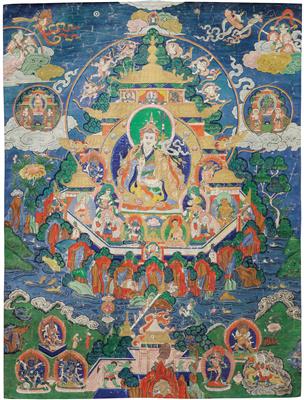A thangka ‘The southwestern paradise of Padmasambhava’, Tibet, 19th/20th cent., Nyingma Tradition
A thangka ‘The southwestern paradise of Padmasambhava’, Tibet, 19th/20th cent., Nyingma Tradition

pigment with a water-soluble binding agent on textile, gold paint, image size 74 x 56 cm, full size with brocade mount 129 x 94 cm, (Hr)
We are grateful to Mr Uwe Niebuhr for his assistance with cataloguing this work.
This thangka depicts the southwestern paradise of the famous tantric master, Padmasambhava (Tib.: pad ma 'byung gnas), who is supposed to have lived in the 8th century, according to our chronology, and to have had his origins in Uddiyana in the north-west of Kashmir. The gleaming copper-coloured mountain depicted, known as Zangdong palri (Tib.: zangs mdog dpal ri), lies in the Ngayab Lanka Ling region (Tib.: rnag yab lang ka'i gling) or Camara. It is believed that Padmasambhava taught the Dharma there and held court in a large three-storey palace on an island, that could only be reached via a small bridge.
Padhmasambhava is depicted in the centre of the thangka in his traditional form on a large lotus inside his palace. His right hand makes a threatening gesture (Skt.: tarkani mudra; Tib.: sdig mdzub) and he holds a vajra (Tib.: rdo rje) in front of his chest, whilst his left hand rests on a skull dish (Skt.: kapala, Tib.: thod pa). He also rests a tantric rod (Skt.: khatvanga) against his left shoulder. His body is wrapped in a variety of colourful silk robes. Padmasambhava wears his characteristic winged hat made of polychrome silk brocade, which is surmounted by a half-vajra and a feather. He is encompassed by a blue-gilt mandorla with rainbow-coloured edges and his head by a green nimbus.
To his right and left, Princess Mandarava and Yeshe Tshogyal are seen kneeling. In a clockwise direction, they are surrounded by eight figures: Dorje Drolo, Nyima Oser, Loden Chogse, Shakya Sengge, Orbyan Dorje Chang, Pema Gyalpo, Pema Jungne and Sengge Drador. The palace’s first storey is encompassed by a wall, in the gates of which three of the four Heavenly Kings can be seen: Vaisravana (north), Dhrtarastra (east) and Virudhaka (south). The concealed second storey is surmounted to its centre by a third.
Esperta: Regina Herbst
 Regina Herbst
Regina Herbst
+43-1-515 60-356
regina.herbst@dorotheum.at
08.04.2019 - 14:00
- Prezzo di partenza:
-
EUR 1.800,-
A thangka ‘The southwestern paradise of Padmasambhava’, Tibet, 19th/20th cent., Nyingma Tradition
pigment with a water-soluble binding agent on textile, gold paint, image size 74 x 56 cm, full size with brocade mount 129 x 94 cm, (Hr)
We are grateful to Mr Uwe Niebuhr for his assistance with cataloguing this work.
This thangka depicts the southwestern paradise of the famous tantric master, Padmasambhava (Tib.: pad ma 'byung gnas), who is supposed to have lived in the 8th century, according to our chronology, and to have had his origins in Uddiyana in the north-west of Kashmir. The gleaming copper-coloured mountain depicted, known as Zangdong palri (Tib.: zangs mdog dpal ri), lies in the Ngayab Lanka Ling region (Tib.: rnag yab lang ka'i gling) or Camara. It is believed that Padmasambhava taught the Dharma there and held court in a large three-storey palace on an island, that could only be reached via a small bridge.
Padhmasambhava is depicted in the centre of the thangka in his traditional form on a large lotus inside his palace. His right hand makes a threatening gesture (Skt.: tarkani mudra; Tib.: sdig mdzub) and he holds a vajra (Tib.: rdo rje) in front of his chest, whilst his left hand rests on a skull dish (Skt.: kapala, Tib.: thod pa). He also rests a tantric rod (Skt.: khatvanga) against his left shoulder. His body is wrapped in a variety of colourful silk robes. Padmasambhava wears his characteristic winged hat made of polychrome silk brocade, which is surmounted by a half-vajra and a feather. He is encompassed by a blue-gilt mandorla with rainbow-coloured edges and his head by a green nimbus.
To his right and left, Princess Mandarava and Yeshe Tshogyal are seen kneeling. In a clockwise direction, they are surrounded by eight figures: Dorje Drolo, Nyima Oser, Loden Chogse, Shakya Sengge, Orbyan Dorje Chang, Pema Gyalpo, Pema Jungne and Sengge Drador. The palace’s first storey is encompassed by a wall, in the gates of which three of the four Heavenly Kings can be seen: Vaisravana (north), Dhrtarastra (east) and Virudhaka (south). The concealed second storey is surmounted to its centre by a third.
Esperta: Regina Herbst
 Regina Herbst
Regina Herbst
+43-1-515 60-356
regina.herbst@dorotheum.at
|
Hotline dell'acquirente
lun-ven: 10.00 - 17.00
kundendienst@dorotheum.at +43 1 515 60 200 |
| Asta: | Antiquariato |
| Tipo d'asta: | Asta in sala |
| Data: | 08.04.2019 - 14:00 |
| Luogo dell'asta: | Wien | Palais Dorotheum |
| Esposizione: | 02.04. - 08.04.2019 |
